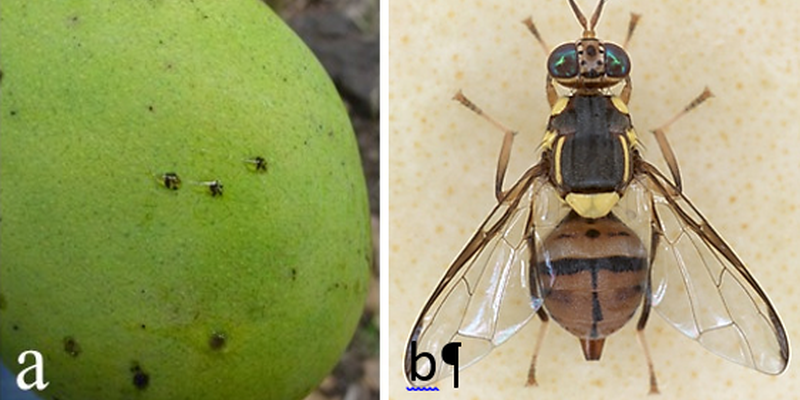Bactrocera dorsalis - New IPPC Diagnostic Protocol adopted
Posted on Пн, 25 Фев 2019, 08:50

DP 29: Bactrocera dorsalis: a) oviposition punctures on mango fruit mark spots where fruit flies lay their eggs. B) example of a female Bactrocera dorsalis. Photos courtesy of Luc Leblanc (University of Idaho, USA) and Yokohama Plant Protection Station, Japan.
The IPPC Standards Committee has adopted a new diagnostic protocol (DP) on behalf of the Commission on Phytosanitary Measures. The adoption of the DP 29: Bactrocera dorsalis comes at the closing of the DP Notification Period on 20 February 2019.
This new DP will help countries prevent the entry or establishment of harmful fruit flies affecting numerous fruit species worldwide.
The fruit fly genus Bactrocera within the family Tephritidae consists of over 460 described species, mostly distributed in the Asia-Pacific region. Common in Asia, Australasia and the subtropical islands of the southern Pacific, the Oriental fruit fly Bactrocera dorsalis is also spreading worldwide via international travel and trade. Given its broad host range and reproductive potential, this invasive species may easily disperse into new territories and establish. The establishment of the oriental fruit fly can have serious economic and environmental impact, as it outcompetes native fruit flies and requires costly phytosanitary measures.
DP 29 provides guidance to diagnose adult Bactrocera dorsalis fruit flies and also describes five economically important species of the Bactrocera dorsalis complex (B. carambolae, B. caryeae, B. kandiensis, B. occipitalis and B. pyrifoliae). All of these species are found in commercial fruits and vegetables, but can be easily confused with B. dorsalis due to their similar morphology. The identification of those pests is based on morphological characters distinguishing one species from another. In addition, the new adopted DP describes also a molecular method to assist countries in distinguishing B. carambolae from B. dorsalis where morphological examination alone is not conclusive.
29 diagnostic protocols (DPs) are now in the suite of adopted annexes to ISPM 27 (Diagnostic protocols for regulated pests), providing specific guidance for the diagnosis of a wide range of pests - insects, nematodes, weeds, bacteria, fungi and viruses. A complex and long workflow ensures that adopted DPs reflect international best practices and guidance are globally applicable to phytosanitary systems. Drafting groups composed by diagnostic experts develop DPs that are further reviewed by the Technical Panel on Diagnostic Protocols (TPDP), a group of international experts nominated by the Standards Committee (SC). DPs are then submitted to international consultations and finally reviewed by the SC. Good diagnostics relies on a number of factors, including the availability of human and financial resources. Having internationally accepted protocols is crucial, especially for those countries that do not have the resources to develop protocols of their own.
As outlined in the CPM Recommendation 7, accurate and rapid pest diagnosis underpins phytosanitary certification, import inspections and the application of appropriate phytosanitary treatments.
Read more about the work on DPs and the TPDP at https://www.ippc.int/en/core-activities/standards-setting/expert-drafting-groups/technical-panels/technical-panel-diagnostic-protocols/.
The newly adopted DP will soon be available at the Adopted Standards (ISPMs) webpage: https://www.ippc.int/en/core-activities/standards-setting/ispms/.
For more information on the DP Notification Period, please visit: https://www.ippc.int/en/core-activities/standards-setting/notification-period-dps/.

